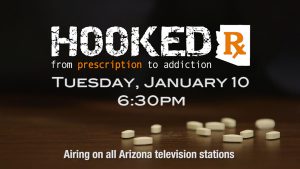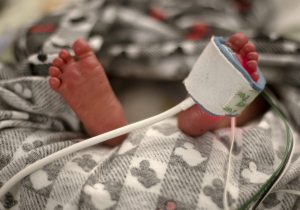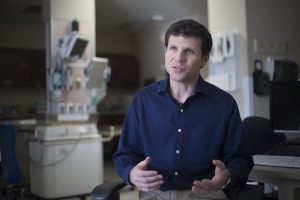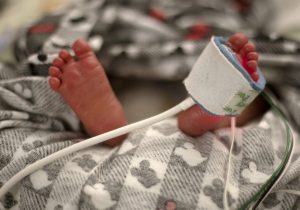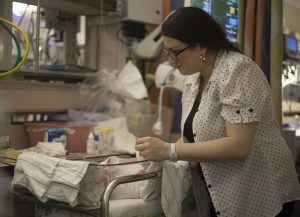- Slug: BC-CNS-Opioids Babies,2,500
- Photos available (thumbnails, captions below)
- EDS: PLEASE RUN THE HOOKED PROMO PHOTO (below) OR THIS BOX WITH THIS STORY IF YOU PLAN TO PUBLISH PRIOR TO JAN. 10: Watch “Hooked Rx: From Prescription to Addiction,” a 30-minute commercial-free investigative report airing at 6:30 p.m. on Jan. 10 on 30 broadcast TV stations in Phoenix, Tucson and Yuma and 97 of the state’s radio stations. For the full report, go to hookedrx.com.
By CLAIRE CLEVELAND
Cronkite News
PHOENIX – Laianna Denny was born addicted to methadone, her small arms trembling and body shaking from the drug her mom used to fight off her heroin addiction. It was Dec. 19, 2015, and the baby was just hours old.
“Having a baby is something that creates a whole different world for you. You fall in love immediately when you see that baby,” said Carissa Denny, Laianna’s mother. “To see her withdraw and go through some of those physical symptoms. … She would cry all the time, and seeing that tiny, innocent piece of life that I created struggling and just absolutely miserable because of me, and something that I did, was just, I don’t even know a term for it, it’s horrible. … It’s horrible.”
Months earlier in July, Carissa Denny was outside a trailer home throwing up. She thought she was dope sick, going through withdrawal, so she shot up more heroin over and over again, trying to quell the illness. She also was pregnant.
But even with the heroin, her sickness didn’t go away. Later, at a hospital, she was diagnosed with sepsis and an infected gallbladder. While in the intensive care unit at the hospital, doctors started Denny on methadone, an opiate replacement drug used to treat withdrawal symptoms in drug addicts without giving them the addictive high.
In pregnant women, it’s used to ensure the fetus has a relatively stable environment during pregnancy. Withdrawing cold turkey from heroin and other prescription drugs can result in miscarriage.
“I knew that if I kept using heroin, she wouldn’t die, but she would potentially die if I stopped using. Plus, it’s impossible to just stop using,” said Denny, whose opiate addiction started in 2011 after she broke her ankles in a car accident and was prescribed Percocet.
“I didn’t want to have the baby in jail or prison or anything like that, but eventually I just gave up,” she said. “I was like, ‘I need help. I can’t do this. I cannot keep getting high. I am exhausted. I’m gonna die if I don’t get help. I don’t care if I got to jail, whatever.’”
Denny discovered she was pregnant while living in a Motel 6 in Mesa with her boyfriend, the father of her unborn baby. Her boyfriend’s mother, a prostitute, also lived in the room. Three weeks later, authorities arrested and jailed Denny’s boyfriend. She was wanted for a parole violation.
A baby’s exposure to opiates and other drugs in utero and the subsequent withdrawal is called Neonatal Abstinence Syndrome. In Arizona, the rate of NAS has increased more than 218 percent between 2008 and 2014, according to the Arizona Department of Health Services. It also leads to Sudden Unexpected Infant Death, developmental delays and problems with learning.
Infants born addicted to methadone have to be weaned off the drug and experience withdrawal symptoms just as an adult would. They exhibit high-pitched crying, vomiting, diarrhea, tremors, excoriations, sweating, failure to thrive, poor feeding and on the extreme end, they can even have seizures, said Dr. Nathan Lepp, a Phoenix neonatologist.
Denny delivered Laianna at the Abrazo Central Campus hospital in Phoenix. Just over 6 pounds, with fair blond hair, snowy white skin and crystal-blue eyes, Laianna earned the nickname “little princess.”
Although Lainna was small, she wasn’t like the other infants in the neonatal intensive care unit who were born too early or with serious medical problems. Laianna was in pain, but otherwise relatively healthy.
That’s the case with many NAS infants, Lepp said. In the busy NICU at Maricopa Medical Center in Phoenix, Lepp is treating four infants with NAS – not an unusually high number. The most he’s ever seen was 15 at once.
He strolls through the NICU and nurses standing over raised and covered infant beds greet him. The room’s lights are dim, monitors beep. A nurse quickly changes a tiny infant’s outfit so he doesn’t get cold. She picks a red-, blue- and white-striped hat for his head, which isn’t much larger than a small orange.
Lepp points out the four NAS infants; they look nothing like the ventilated, premature babies in the covered beds. They’re average sized newborns, swaddled tightly; some of them look around the room, watching as the nurses hurry by.
“We’re designed to take care of sick babies on ventilators, or who are preterm or who have surgical issues. Most NICUs aren’t designed to take care of a baby who’s alert and active and term, and just crying a lot or having withdrawal,” he said. “They can have these symptoms that can be very disruptive, because it’s a child who needs a lot of attention, and you can’t necessarily use a nurse one-on-one with them.”
The drastic increase in NAS has not only forced NICUs to adapt, it also has burdened the Arizona Health Care Cost Containment System, which has been the payer in 76 percent of the newborns exposed to narcotics from 2008-2014, according to the Arizona Department of Health Services Hospital Discharge Database.
In 2012, the cost of NAS treatment in the NICU nationally was $66,700 per patient with an average hospital stay of about 17 days, as compared to $3,500 and an average stay of 2.1 days for infants without NAS, according to the National Institute on Drug Abuse.
“It’s been a very large challenge, and it can be very emotionally challenging for nursing, because it’s heartbreaking for all of us who care about babies to watch them go through withdrawal,” Lepp said. “We can treat them with the narcotics and that helps, but just to see them so miserable is really emotionally challenging for a lot of the caregivers, both nurses and staff, because nobody likes to see a baby suffering like that.”
Katherine Davis, a registered nurse who works at the Abrazo Central Campus, worked with drug-exposed newborns in the 1980s. As she and the other nurses saw more and more NAS infants, she realized the need for compassion over judgment in the NICU.
“I focus in on the fact that it’s a disease, and the fact that maybe these young ladies never caught a break,” Davis said. “To tap into the facts, keep your emotions out of it, just stick to the facts, as if you would in any other situation. It’s so profound to us because it’s a baby, and ‘she should know better, how could she?’ – those are emotions.”
Prescription drug use has ballooned in the past 25 years and NAS has increased steadily with that, Lepp said.
“Every state’s been affected, and I think that’s a really important message too. This is an epidemic that affects everyone,” Lepp said. “It doesn’t matter what your income, doesn’t matter your educational status, it doesn’t matter your ethnicity, it doesn’t matter your religion – it cuts across all this and across the Phoenix area and across the state, it cuts across everything. It’s not just a problem at a our downtown urban hospitals, this is a suburban problem, this is a rural problem.”
Nestled into a neighborhood off 15th Avenue and Osborn Road in Phoenix are two rectangular housing units that sit parallel to one another. In the middle is a grassy area with a plastic baby pen and a canopy over a table and some chairs. Hip-high wrought-iron fences complete the rectangle that encloses the small yard. When the residents of Sally’s Place aren’t tending to their babies or attending meetings, they sit, smoke and chat.
The residential housing program puts an emphasis on long-term treatment that goes beyond detoxing and 30 days of sobriety. Women, as long as they stay sober and continue working on their sobriety, can stay for up to five years, allowing them the time to learn skills such as parenting, budgeting and sober living.
This is where Denny and her baby live now.
While Denny was still pregnant and recovering from her stay in the hospital for sepsis, she went to Life Well, a nonprofit health care agency providing treatment for low-income clients diagnosed with serious mental illness, general mental health issues and substance abuse disorders. She was later transferred to Sally’s Place, which is run by the National Council on Alcoholism and Drug Dependence.
Thelma Ross, CEO of the Arizona division of NCADD, considers Sally’s Place one of the organization’s most significant accomplishments.
“As a society we have got to stop judging these women and start helping,” she said. “If a woman is stepping up and coming through that door and saying ‘I’m pregnant and I need help,’ we should never slam that door in their face, we should open it and welcome them and support them. I think it takes an amazing woman to do that.”
Ross is a recovering alcoholic and has worked in addiction for 40 years. She has spent the past 17 years with NCADD.
“I’ve been in this field way too long because this is generational,” she said. “What really saddened me a few months ago is I saw the grandson of a woman I treated probably 30 years ago in here with his mother. It shouldn’t be that way. We’ve gotta do something to change it.”
Sally’s Place wasn’t Denny’s first attempt at recovery. In 2013, she went to Riversource Rehab in Mesa for a 30-day recovery program after supervisors fired her for nodding off at her desk and doing pills during her lunch breaks.
By day 25, she was kicked out for fraternizing with a man who was also in the program. She had nowhere to go. Her parents had paid $10,000 out of pocket for her attendance.
“They had paid all that money, which made me feel horrible,” she said. “I had a lot of guilt and a lot of shame for it.”
Rick Christensen is the chief medical officer at Community Medical Services, a statewide outpatient opiate treatment program, and he has more than 30 years experience in substance abuse treatment.
“Detox does not work for anyone, anywhere, anytime, ever. Why not? Because when you’re done, the brain does not return to normal. What tells you your brain isn’t normal is craving,” Christensen said. “Craving happens in the same part of the brain as hunger and thirst. That’s why diets don’t work, when you’re hungry, you eat, when you’re thirsty you drink, when you crave you use.”
At Sally’s Place after having Laianna, Denny’s motivation to stay clean was strengthened. She started to build relationships with the other women and was growing into her role as mother until an old warrant popped up.
“I had a 3-month-old baby in my arms, and I had to give her to staff so that I could go to jail,” she said. “I thought, ‘I’ll never see this baby again, or I will but she’ll be 6, 7 or 8.’ I was also thinking ‘I don’t ever get arrested sober, I’m usually on drugs, I don’t know how to handle this sober, I need to be high for this, I don’t know what to do sober.’”
In her court hearing the next day, Denny caught a break. She was released and allowed to attend the rest of her court dates as a free woman. In the courtroom, she dropped to her knees and thanked the judge.
On any given day, the Maricopa County Fourth Avenue Jail in downtown Phoenix processes 400 new inmates. Each and every one of them is tested for drugs, and if necessary, female intakes are tested for pregnancy.
“Many women, when they come in, we’re the ones to tell them that they’re pregnant, so they never even knew or thought about it,” said Dr. Jeffrey Alvarez, director of Correctional Health Services. “Consistently, we have anywhere between five and 10 pregnant females who are opiate positive when they enter into the facility that then require a methadone substitution.”
If these women test positive for pregnancy and narcotic drug use, then they will receive methadone while serving their sentence, but this wasn’t always the case.
Alvarez started working for Maricopa County Correctional Health Services in 2009 as a provider at Estrella Jail, which houses mostly women. Inmates who needed methadone treatment when he started would be transported offsite to a hospital to receive their dosing.
“Opiate treatment in jails is really difficult,” Alvarez said. “It took me two years to try to get all the logistics worked out.”
In 2010, he was promoted to director and began working with the Drug Enforcement Administration and the Substance Abuse and Mental Health Services Administration to bring methadone into the Maricopa County corrections system.
Today, four of the six jails in Maricopa County, including the tents, are certified to prescribe methadone and offer counseling to addicts.
“The jail is very important because this patient population isn’t connected to the community, so they’re kind of lost in some ways,” Alvarez said. “We can’t just keep addicts in jail and keep the patients here until they’re healthy again, that has to be a community resource that we link them to. Our job is to be the link.”
One of those community resources is Community Medical Services, where Christensen is medical director. He and Alvarez work together to ensure that once women are out of jail, they can continue their medication assisted treatment.
“Five years ago, 90 percent of the women that were started on methadone because they were pregnant went back to the streets,” Christensen said. “Now, 95 percent when they’re released come to the methadone treatment program or a residential treatment program. We’ve stopped that revolving door.”
The NCADD is another community partner working with county corrections to pull pregnant women from the jails upon release and get them into residential treatment programs like Sally’s Place.
Outside their apartment at Sally’s Place, Denny and the some of the other women are sitting under the canopy smoking cigarettes and talking about their babies – some nearly a year old, others who have yet to be born.
Denny has been sober for 17 months and is still living at Sally’s Place with Laianna, who just turned 1 year old. She plans to start taking classes in the spring to complete her college degree and then go into addiction counseling.
And she’s trying to let go of her past.
“I can’t hold onto it anymore, because if I hold onto it, it’s just going to hurt me,” she said. “It happened. I did it. It would only hinder my recovery if I held onto it.”
That transition is what continues to motivate Ross and the addiction specialists she works with at the NCADD.
“I get to come here and see miracles,” she said. “We get to see babies be born and new lives come about, and mothers be committed to making their baby’s life as healthy and as safe as possible.”
^__=
In Arizona, the rate of Neonatal Abstinence Syndrome has increased more than 218 percent between 2008 and 2014, according to the Arizona Department of Health Services. (Photo by Johanna Huckeba/Cronkite News)
Dr. Nathan Lepp, a Phoenix neonatologist at Maricopa Integrated Health System, said newborns with Neonatal Abstinence Syndrome are “emotionally challenging for a lot of the caregivers.” (Photo by Johanna Huckeba/Cronkite News)
In Arizona, the rate of Neonatal Abstinence Syndrome has increased more than 218 percent between 2008 and 2014, according to the Arizona Department of Health Services. (Photo by Johanna Huckeba/Cronkite News)
Tara Spillman spends time with her newborn, Maxton, at a neonatal intensive care unit in the Maricopa Integrated Health System. He was born while his mother was in custody. (Photo by Johanna Huckeba/Cronkite News)
Carissa Denny (left) and Kyla Wall hold Jayden at Sally’s Place in Phoenix, a residential housing program that puts an emphasis on long-term treatment that goes beyond detoxing and 30 days of sobriety. (Photo by Johanna Huckeba/Cronkite News)
Tara Spillman spends time with her newborn, Maxton, at a neonatal intensive care unit in the Maricopa Integrated Health System. He was born while his mother was in custody. (Photo by Johanna Huckeba/Cronkite News)
